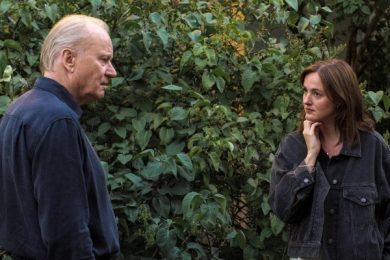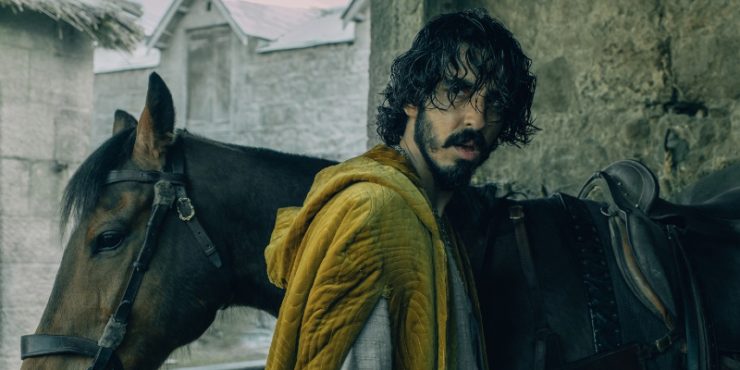Arthurian legends have persevered over centuries with their tales of honor and faith. Conceived as bloated epics, dainty Disney cartoons and brash adventure tales. In 2017, Guy Ritchie made King Arthur into a gritty, bare knuckle brawler fighting through the middle ages with stained hands and grit. With The Green Knight, writer-producer-director-editor David Lowery seems to be doing something entirely different. The magic and trickery intrigues him, but so too does the unknown. His telling of the Sir Gawain legend is tinged with existential doubts, internal fears and subconscious lust. This humanist approach is refreshing, crafting a wondrous experience as opposed to a Sparknotes-esque explanation.
Lowery, a director known mostly for his visually exquisite, thematically ponderous indie films, gets to go big here. This feels like the best of what he can bring to the table. No longer feeling like discounted Terrence Malick, Lowery takes an epic scope toward this tale of a scabrous young man and his quest to achieve knighthood in the most unlikely of ways. Gawain is played by Dev Patel, whose late-blooming evolution from Slumdog Millionaire to Hollywood hunk gives The Green Knight its perfect leading man. The structure of Gawain (of which the author is unknown) gives some stability to Lowery’s usually unwieldy abstractions, and gives a sense of direction to his arresting use of imagery.
Gawain, the son of a witch (Sarita Choudhury) and a frequenter of brothels, seems an unlikely candidate for knighthood, but as he enters the Christmas celebration of the king (Sean Harris), he keeps a modest hope. Holiday revelry is interrupted, however, by the arrival of the Green Knight (Ralph Ineson), a towering figure seemingly made of tree bark – a menacing Groot. He holds a massive axe and asks the party if they’d entertain a game. If any of the brave knights present can battle him and manage to land a blow, in one year’s time, the same man will have to meet him at the Green Chapel to receive the same blow in kind. After a moment of timid silence, Gawain takes up the challenge and manages to lob off the Green Knight’s head. The Green Knight casually picks up his head and reminds Gawain: in one year, he will repay the blow.
Most of the film takes place a year later, where Gawain, obviously worn down by the pressure of his upcoming trek, worries about the consequences of his action. Through the encouragement of the king (they make a point not to use the name ‘Arthur’), Gawain decides to keep his word and head to the Green Chapel. He leaves behind a lover, Essel (Alicia Vikander), a commoner whom he promises to make a lady after he’s completed his journey and gained his knighthood. His trip to the Green Chapel includes an encounter with a traitorous thief (Barry Keoghan), a night with the spirit of a headless woman named Winifred (Erin Kellyman), and a friendly fox who comes in handy in various ways. Like most epics, Gawain’s main purpose gets delayed by side missions and insistent guest characters.
When he stops at the home of a local lord (Joel Edgerton) who has heard of his exciting journey, he’s treated to a comfortable stay on the lord’s expanded estate. The lord, as well as his wife (also played by Vikander), quickly sink Gawain into a troubling love triangle, where everyone seems to be horny and no one seems to care about the Green Knight. That whole episode is conceptual and hard to grasp, even more so than everything that comes before it. Edgerton and Vikander both play coy and deceptive in their pursuit, and Patel’s Gawain becomes hopeless in their advances. It’s a segment filled with eroticism that still maintains the film’s thematic motif of self-examination and faith in your own inner strength. It’s also the moment that I realized The Green Knight was really special.
I wouldn’t deign to say that I truly understood everything that I was watching in The Green Knight and I think that is part of the allure. Lowery’s interest in mythologies connects to his explorations of human psychology, and he doesn’t seem to be interested in what’s on the surface. And so, he crafts a wondrous visual experience, filming across the cloudy green hills of rural Ireland, following Gawain as he crosses the gorgeous but treacherous countryside. The film’s script – episodic and elliptical – jumps from one mystical adventure to the next, but never feels in a rush. For Lowery, patience is a necessity and a virtue. His willingness to linger can become tedious, but here he builds profundity as the stakes and difficulty of Gawain’s journey grow larger and larger.
Mostly, I find myself at a loss for words as to how to explain The Green Knight. I want to heap praise on cinematographer Andrew Droz Palermo and film composer Daniel Hart, both of whom add irreplaceable elements to this stunning piece of filmmaking. I want to say how the pure majesty of what I watched cured my skepticism of Lowery as a filmmaker. That he’s seemed to find the perfect home for his tales of haunted melancholy. I want to tell the world about the great performances from Dev Patel and Alicia Vikander, both works of mercurial beauty that enhances the heart of the film, but also the mystery. I’m struggling to find a way to say this coherently, and perhaps that’s because The Green Knight is a film to be seen and not deconstructed. A true work of cinema that can only be appreciated on the biggest screen you can find.
Written for the Screen and Directed by David Lowery










